




Wainwright, A: 1966: Western Fells: Westmorland Gazette (Kendal, Westmorland):: Grey Knotts (5)
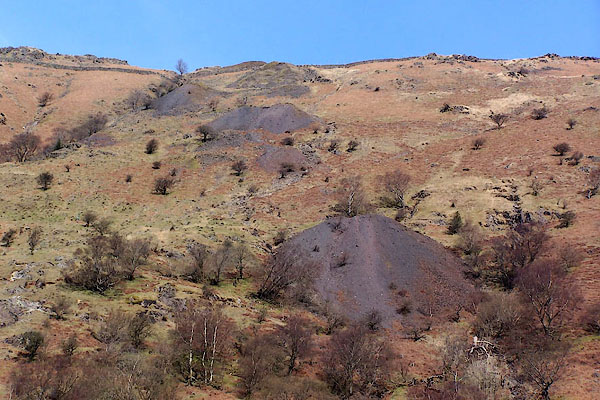
BLY04.jpg (taken 24.4.2006)
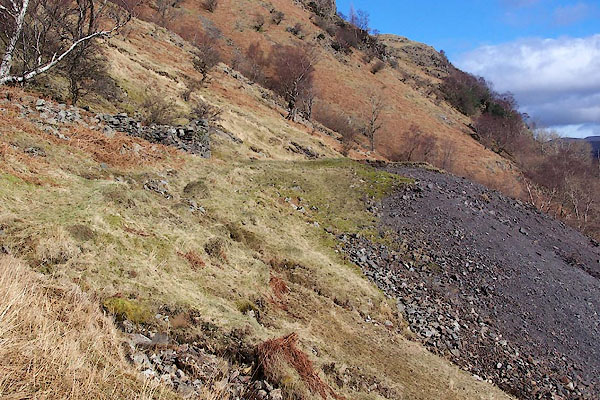
BNG41.jpg Ruined building and tip.
(taken 26.2.2007)
placename:- Plumbago Mines
 goto source
goto sourcesecond page:- "[at Keswick and Newland] ... the Blacke Lead is gotten, whose plentie maketh it of no great esteeme; otherwise a commoditie that could hardly be missed."
placename:-
item:- black lead; plumbago
"... Here [Derwent Fells] are still mines of black lead found, which turn to a very good account, being, for ought I have yet learned, the only place in Britain where it is to be had."
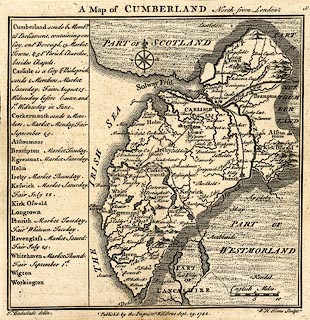 click to enlarge
click to enlargeBD10.jpg
"Black Lead Mines"
labelled by hillocks
item:- JandMN : 115
Image © see bottom of page
 goto source
goto source"... The chief Commodities [of Cumberland] are ... Black Lead, (call'd by the Inhabitants Wadd,) ... The Black Lead, which is almost peculiar to this County, is not properly a Metal or Mineral, but rather an Earth, strongly impregnated with the Streams of Lead: There is more of it here than suffices for the Consumption throughout Europe. ..."
 goto source
goto sourceGentleman's Magazine 1747 p.583 "SIR,"
"I Am very glad that such remarks as I have been able to make, are so agreeable to your readers. - For their satisfaction I must inform you, that wadd mines in the Cumberland Dialect, signifies the black-lead mines, being synonymous terms. Their cause and nature has employ'd the great Bp Nicolson in two manuscript letters, whose opinion, with my own, I intended to transmit to you; but as I could not have the opportunity of seeing them myself, I defer publication till a better opportunity. We are positive the whole world affords not another, nor does it appear the Romans ever knew of this. It was accidentally discover'd by a tree blown up by the roots in a tempest.-"
"The produce has nothing in common with lead but the name, not being fusible in any fire. The mines are seldom opened, except a great demand require it; tho' notwithstanding the vigilance of the owners, it may be procured from the smugglers thereabouts; it sells at 6s. 6d. per lb. generally.-"
"The inclemency of the weather, and rocks of so formidable ascent, prevented my intention to see them."
"Yours &c."
 goto source
goto sourceGentleman's Magazine 1747 p.522 "[on the way to Caldbeck Fells] ... My intention in this journey was to visit the Wadd-mines, the peculiar product of these mountains, and no where else discovered on the globe; but as they are kept close shut up, and the weather was extremely unfavourable, I deferred that examination to a more proper time, ..."
Seathwaite black lead mines are not in Caldbeck Fells.
placename:- Black Lead Mines
item:- black lead; graphite
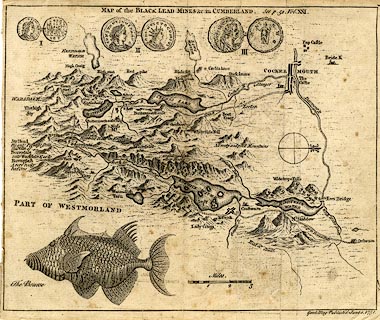 click to enlarge
click to enlargeGM13.jpg
"MAP of the BLACK LEAD MINES &c. in CUMBERLAND See p.51. Vol.XXI."
Map, uncoloured engraving, Map of the Black Lead Mines in Cumberland, and area, scale about 2 miles to 1 inch, by George Smith, published in the Gentleman's Magazine, 1751.
The map includes Cockermouth, Keswick, Borrowdale etc, south to Seathwaite.
The map was published in June 1751 to accompany an article by GS, in the issue for February 1751, vol.21 opposite p.51. The extra items are for other articles in the magazine. The magazine title page, May 1751, which is p.191, says "With a Map of the Black Lead Mines in Cumberland, in which is tracked Mr Smith's journey, related p.51. A Representation of several ancient Coins found about Porchester Castle, near Portsmouth; and an uncommon Fish called a Bourse ..."
item:- JandMN : 114
Image © see bottom of page
placename:- Black Lead Mines
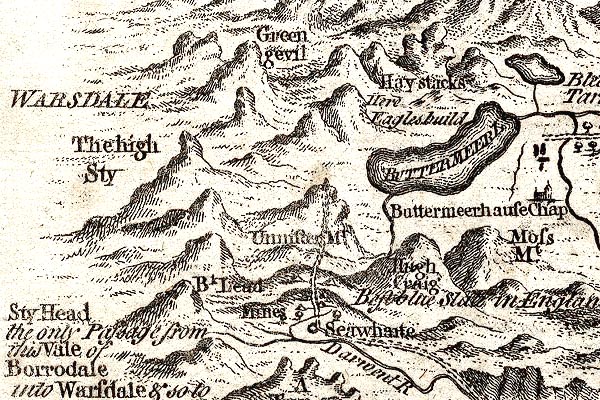
GM1305.jpg
"Bk. Lead Mines"
marked by caves above Seathwaite
item:- JandMN : 114
Image © see bottom of page
 goto source
goto sourceGentleman's Magazine 1751 p.51
Report of a visit to the black lead mines above Seathwaite, by GS, George Smith, published in the Gentleman's Magazine, London, February 1751. "THE Gentleman's Magazine: For FEBRUARY 1751."
"Mr URBAN,"
"THE public attention has been drawn to the black lead mines, in Cumberland, call'd the Wad, by the account of their having been plundered, which has lately appear'd in the papers: but as yet they have not been described, and though it is not known that there is any other mine of the same kind in the world, yet, I believe, they have never been visited with a view to natural history, except by myself, and some gentlemen who went with me. I, therefore, send you the following narrative of our journey and discoveries, which, I hope, will be acceptable to your readers. Yours, &c. G.S."
"I Had long intended a journey to the Wad, and had often been prevented from effecting it by unfavourable weather, and other accidents; but in the beginning of Aug. 1749, I set out from Wigton, in company with two or three friends, and had appointed others to meet us from Cockermouth, who waited only for my message to set out; for as this expedition had been long projected, they had determined to bear me company.- From Wigton, in about 3 hours, we arrived at Orthwaite, a small village under mount Skiddow: (See Vol.XVIII. p.292). A sudden storm of rain obliged us to take shelter in a little alehouse at this place, and an uninterrupted series of bad weather kept us prisoners near a week; ..."
 goto source
goto sourceGentleman's Magazine 1751 p.53 "... we arrived at Seathwaite, which is just under the mines, and, as near as I can compute, about 10 miles distant from Keswic. The scene that now presented itself was the most frightful that can be conceived; we had a mountain to climb for above 700 yards, in a direction so nearly perpendicular, that we were in doubt whether we should attempt it; however, recovering our resolution, we left our horses at a little house that stood by itself, on the utmost verge of the county, and approached the mountain. The precipices were surprisingly variegated with apices, prominences, spouting jets of water, cataracts, and rivers that were precipitated from the cliffs with an alarming noise."
"One of these rivers we passed, over a wretched foot-bridge, and soon after began to climb; we had not ascended far before we perceived some persons at a great distance above us, who seemed to be very busy, tho' we could not distinguish what they were doing; as soon as they saw us, they hastily left their work, and were running away, but by a signal made by our guide, who probably was but too well acquainted with them, they returned, to the number of 18. We came up to them after an hour of painful and laborious travelling, and perceived them to be digging with mattocks, and other instruments, in a great heap of clay and rubbish, where mines had been formerly wrought; but tho' they were now neglected by the proprietors, as affording nothing worth the search, yet these fellows could generally clear 6 or 8 shillings a day, and sometimes more."
"The black lead is found in heavy lumps, some of which are hard, gritty, and of small value, others soft and of a fine texture. The hill in which it is found is a dirty brittle clay, interspersed with springs, and in some places shivers of the rock. The hazel grows in great plenty from the bottom to the height of above 300 yards, but all the upper part is utterly barren."
"The mineral has not any of the properties of metal, for it will not fuse but calcine in an intense fire: before its value was discovered the farmers used it as those of the S. counties do ruddle, to mark their sheep; it is not the petroleum, the melanteria, nor the pinguitis of the ancients, nor does it agree with any description in Pliny, or Aldrovandus."
"About 150 yards above this rubbish is the miner's lodge, to which the ascent is very steep, and here the facts related in the news papers must have happen'd, if at all, for the principal heap of rubbish, where several fellows and girls were then at work, is within pistol shot of the hut."
"We had now reached the summit of the black lead hill, but were astonished to perceive a large plain to the West, and from thence another craggy ascent of 500 yards as near as I could guess."
"..."
"P.S. The lumps of black-lead found in the rubbish seldom exceed half a pound in weight, but those found in the mines are said to weigh six or seven pounds, they work forward for it, and the pits resemble quarries or gravel pits."
"We shall soon give a Map of this place, the only one that was ever drawn."
item:- murder; theft
 goto source
goto sourceGentleman's Magazine 1751 p.40 "... ..."
"Keswick, Cumberland, Jan. 11. A gang of villains, accustomed to steal wadt, or black lead ore from the mine at Borrowdale, (the only one in Europe, see Vol. xvii. p.583) to the value of at least 1000l. yearly, attacked on the 11th past, at night, the house of Mr White, steward of the mine, with fire arms, but losing one of their number by the fire from the place, the rest fled, but had the assurance to go and make oath before a justice that White and his men had murdered one Daniel Wright on which the accused surrender'd and were admitted to bail; one of the rogues afterwards impeached the rest, who all fled except one Dixon, who is committed to the county gaol."
"... ..."
 goto source
goto sourceGentleman's Magazine 1752 p.272
Reports from Parliament:- "... also a petition from John Banks of Kingstonhall, Dorsetshire, Esq; and John Shepheard of Ireland, Esq; setting forth, that they are now in actual possession of all those mines or wad-holes, of wad, or black cawke, commonly called black lead, lying in a very steep, craggy, and desolate mountain, and situated amongst several other mountains of great length and extent in the county of Cumberland (See VOL.xxi. p.53.) and by reason of this desolate and mountainous situation, the said mines are exposed to constant theft and robbery; and therefore praying a bill for more effectual securing the said mines, and for punishing the unlawful breaking, entering, and carrying away the black lead, &c. ..."
placename:- Black Lead Mines
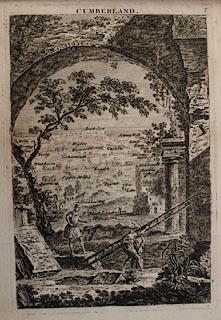 click to enlarge
click to enlargeJL05.jpg
"Black Lead Mines"
view (sort of)
item:- Carlisle Library : 4.2
Image © Carlisle Library
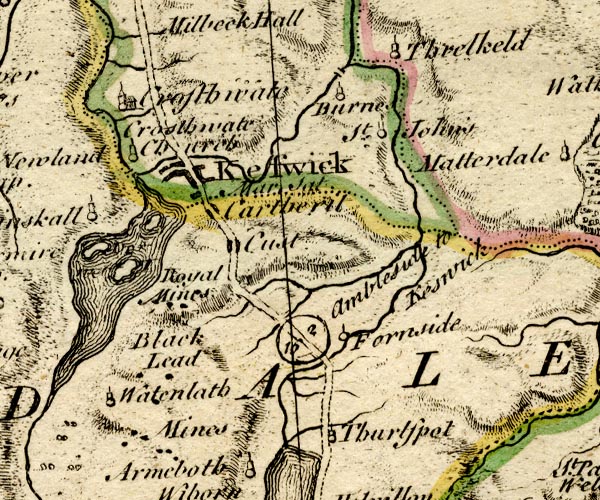
BO18NY21.jpg
"Black Lead Mines"
spots either side of Watendlath
item:- Armitt Library : 2008.14.10
Image © see bottom of page
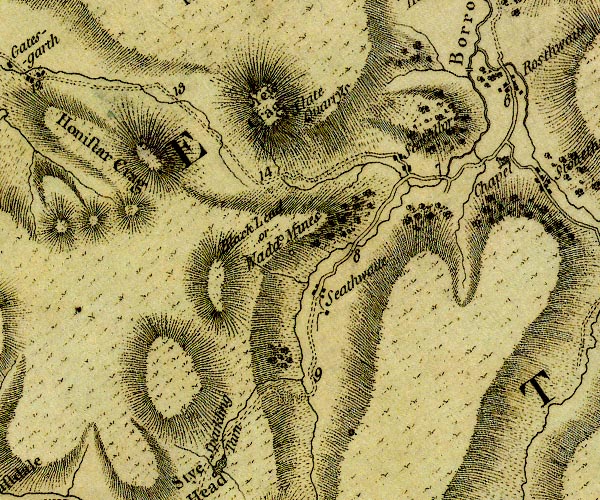
D4NY21SW.jpg
"Black Lead or Wadd Mines"
2 circles
item:- Carlisle Library : Map 2
Image © Carlisle Library
 goto source
goto sourceAddendum; Mr Gray's Journal, 1769
Page 209:- "..."
"... This year the wad-mine has been opened, which is done once in five years: it is taken out in lumps sometimes as big as a man's fist, and will undergo no preparation by fire, not being fusible: when it is pure, soft, black, and loose-grained, it is worth sometimes thirty shillings a pound. .."
item:- mundie; marcassite; smit mark
 goto source
goto sourcePage 82:- "... the black-lead mines; the value and use of this mineral I need not here mention, as they are so well known throughout the whole world."
"The species of mundie, or marcasite, formerly was made no use of by the inhabitants but for marking their sheep, (unless it was by the Dutch;) I am led to this opinion because many of the Dutch miners lived upon Vicar's Island, St Herbert's Island, &c.; and in digging the foundation of Mr Pocklington's house, ploughing the ground, and on the shore, several pieces have been found amongst the earth."
"Since the discovery of its several uses in medicine, dying, glazing of crucible, keeping iron from rust, combs for fair-haired ladies, &c. it has been sold as high as 30s. a pound weight. The Borrowdale black lead is the most valuable of any in the world: they boast of having it in Scotland, Gibraltar, Russia, &c. but all are inferior to it; all are, however, sold for Borrowdale lead, by which many people have been deceived, and have been the cause of many actions at law, as few purchasers are real judges of it till they make trial of it."
 goto source
goto sourcePage 83:- "By an act of parliament of the 25th Geo. II. it is made a felony to break into any mine or wood, or wad-hole, or black chalk, commonly called black lead, or to steal any from thence. And in the recital, it is said to be discovered in one mountain, or ridge of hills, only in this realm (meaning Borrowdale,) and that it hath been found by experience to be for divers useful purposes, and more particularly in the casting of bomb-shells, round shot and cannon, &c."
item:- black lead; drawing; pnigitis; melanteria
 goto source
goto sourcePage 170:- "..."
"... Here [Derwent Fells] is also found in several places that metallic earth or hard glittering stone, which we call Black Lead, used by painters to draw lines and drawings in black and white. Whether it be Dioscorides' Pnigitis, or Melanteria, or ochre burnt black by the heat of the earth, or totally unknown to the antients, I cannot determine, but shall leave it to others. ..."
item:- black lead; melanteria; pnigitis; black chalk; colic; gravel; stone; strangury; crucible; rust preventative; mordant; mundic ore; kellow; wadf; nigrica fabrilis; ruddle
 goto source
goto sourcePage 182:- "..."
"The Black lead is found in Seatallor fell in Keswic parish. It is essentially different from the Melanteria and Pnigitis of Dioscorides; the former being expressly said to be found at the mouth of copper mines, and the latter more like the black chalk mentioned by Dr. Plot. It is used by the neighbourhood medically against colics, gravel, stone, and strangury, operating by urine, sweat, and vomitting. It also enables crucibles to stand the hottest fire, and being rubbed on iron and steel arms preserves them from rust; and it is used by cloth-dyers to make their blues stand unalterable. This mundic ore having little of sulphur in its composition will not flow without a violent heat. It produces a white regulus shining like silver. The old level was first re-opened 1710. It belongs to a number of gentlemen, who, lest the market should be over-stocked, open the mine but once in seven years. It sells from 8 to 12s. a pound. It lies intermixed with a hard greenish rock, in the midst of which it appeared of a full round vein or body of above three feet diameter. It is called here Kellow or Wadf (sic); the former name is supposed to be derived from the Irish, the latter from the Saxon woad. It is said there is a mine of it in the West Indies; but there is no need to import any, as much being found here in one year will serve all Europe for several years. It is rather to be classed with earths than with metals or minerals: and as Ruddle is an earth strongly impregnated with the steams of iron, so is this with those of lead, as appears by its weight, colour, &c. Dr. Merret gives it the name Nigrica fabrilis, adding that it wanted a true one till he gave it this at Keswick, and that it is the peculiar produce of New and Old England; but sir R. Sibbald assures us, it is found in Aberdeenshire."
placename:- Wad Mine
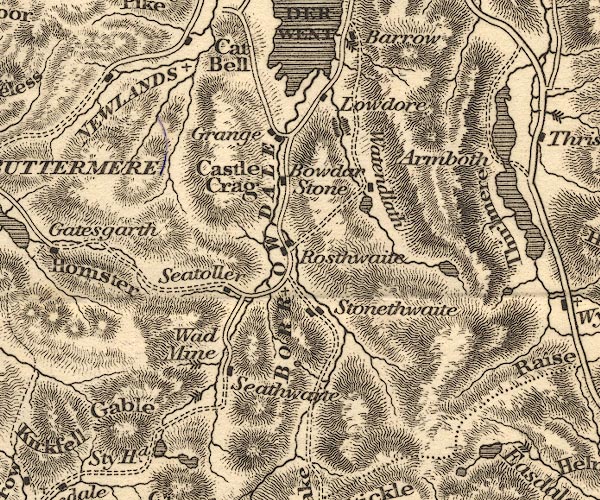
OT02NY21.jpg
item:- JandMN : 48.1
Image © see bottom of page
item:- wad; black cawke; black lead; plumbago; graphite; wad holes; geology; black lead polish; graphite lubricant; pencil
 goto source
goto sourcePage 175:- "THE BLACK-LEAD MINE IN BORROWDALE."
"THE mineral substance from which black-lead pencils are manufactured has successively been known by the several names of wad, black-cawke, black-lead, plumbago, and graphite. In the progress of chemistry and its application to mineralogy, the original term wad was abandoned, probably in consequence of the same name being given by the Germans to a substance somewhat resembling this in appearance, but of a different nature, viz. an oxide of manganese: the term black-cawke might be subject to a similar objection, the word cawke being applied by miners to a sulphate of Barytes: the names of plumbago and black-lead, although still retained in common use, tend to convey an erroneous idea of the subject, as lead forms no part of its composition, which is found to be principally carbon combined with a small portion of iron: and graphite, perhaps the least objectionable term, has scarcely yet obtained currency."
 goto source
goto sourcePage 176:- "This mineral occurs in various parts of the world, and in rocks of different formation. In this island it has been discovered in Invernesshire, in gneiss, which is considered as one of the primitive rocks; there it appears to be intermixed with a micaceous substance and other hard mineral bodies which render it unfit for pencils. In the borders of Ayrshire, it is found in the neighbourhood of coal, to which it seems too nearly allied: but in no place has it been met with equal in purity to that produced from Borrowdale, in Cumberland, where it lies in a rock of intermediate formation."
"We have no account of the first discovery, or opening of this mine; but from a conveyance made in the beginning of the seventeenth century, it appears to have been known before that time. The manor of Borrowdale is said to have belonged to the Abbey of Furness; and having at the dissolution of that monastery, in the reign of Henry the Eighth, fallen to the Crown, it was granted by James the First to William Whitmore and Jonas Verdon, including and particularizing among other things, 'the wad-holes and wad, commonly called black-cawke, within the commons of Seatoller, or elsewhere within any of the wastes or commons of the said manor, now or late in the tenure or occupation of Roger Robinson, or his assigns, by the particulars thereof mentioned to be of the yearly rent or value of fifteen shillings and fourpence.' By a deed bearing date the twenty-eighth day of November,"
 goto source
goto sourcePage 177:- "1614, the said William Whitmore and Jonas Verdon, sold and conveyed unto Sir Wilfred Lawson, of Isle, Knight, and several others therein named to the number of thirty-six, chiefly inhabitants of Borrowdale, 'all the said manor of Borrowdale, with the appurtenances of what nature or kind soever, excepted and reserved unto the said William Whitmore and Jonas Verdon, their heirs and assigns, all those wad-holes, and wad, commonly called black-cawke, within the commons of Seatoller, or elsewhere within the commons and wastes of the manor of Borrowdale aforesaid, with liberty to dig, work, and carry the same, and other their appurtenances whatsoever.' In consequence of which reservation the wad or black-lead mine has been ever since held distinct from other royalties of the said manor, one moiety thereof now belongs to Henry Bankes, Esq. the other half being subdivided into several shares."
"This mine is situated about nine miles from Keswick, near the head of the valley of Borrowdale, in the steep side of a mountain, facing towards the south-east, and has been opened at different places where the wad had probably appeared on the surface: the rock in which it occurs is called by Mr. Bakewell, a grey felspar porphry (sic); near the mine it becomes of a darker colour, as containing more iron, the joints being lined with a ferruginous clayey matter: it is intersected in various directions by strings, or small rake veins, containing in some"
 goto source
goto sourcePage 178:- "places a little calcareous spar, or other vein stuff, and sometimes a superficial glazing of black-lead without the substance; but the wad is only found in sops, or bellies, which appear generally to be formed by the intersection or crossing of the veins, and are often at considerable distance from each other, and found with difficulty."
"Formerly this mine was worked only at intervals, and when a sufficient quantity had been procured to supply the demand for a few years, it was strongly closed up until the stock was reduced; but of late, it has been obtained less plentifully, and the demand being greater, the working has been continued for several years successively."
"An old level, which was re-opened in 1769, was found to have been cut through this very hard rock, without the help of gunpowder; and a kind of pipe vein which had produced a great quantity of wad, having been pursued to the depth of one hundred yards or more, much inconvenience was experienced in working it: to obviate which, in 1798, an adit or level was begun in the side of the hill, which at the length of 220 yards communicates with the bottom of the former sinking; since which time the works have been carried on internally through various ramifications; a survey of which was made a few years since by the late Mr. Farey. Through this principal level the water now passes off, and the produce and rubbish are brought out upon a railway in a small waggon; and over its mouth a house"
 goto source
goto sourcePage 179:- "is built, where the workmen are undressed and examined as they pass through it on leaving their work."
"Owing to the great value of this mineral, and the facilities afforded for disposing of it in an unmanufactured state, the greatest precaution has sometimes been scarcely sufficient to keep the workmen from pilfering, and those appointed to overlook them have not always escaped suspicion; yet, it is but justice to the present manager to state, that for upwards of fifty years that he has been employed, he has always sustained an unimpeachable character."
"To prevent the depredations of intruders, it has sometimes been necessary to keep a strong guard upon the place; and for its better protection, an Act of Parliament was passed 25th Geo. 2d. cap. 10th, by which an unlawful entering of any mine, or wadhole of wad, or black-cawke, commonly called black-lead, or unlawfully taking, or carrying away any wad, &c. therefrom, as also the buying, or receiving the same, knowing it to be unlawfully taken, is made felony. In the preamble of this Act, it is stated to be 'necessary for divers useful purposes, and more particularly in the casting of bomb-shells, round shot, and cannon balls;' however, its use in cleaning and glossing cast iron work, such as stoves, grates, &c. is now well known to every housemaid."
"Being capable of enduring a great heat without fusing, or cracking, it is used in the manufacture of crucibles; and its excellence in diminishing friction in wooden screws, and other machinery, makes it"
 goto source
goto sourcePage 180:- "become an ingredient in several anti-attrition compositions; but effects have been formerly attributed to it in dying, and medicine, which were perhaps only imaginary. Yet its principal use is in pencils, for which Keswick has long been famed; and in their manufactory great improvements have lately been made; but though in the vicinity of the mine, the pencil-makers are obliged to purchase all their black-lead in London, as the proprietors will not permit any to be sold until it has first been lodged in their own warehouse. It was formerly used without any previous preparation; being only cut with a saw to the scantlings required, and thus enclosed in a suitable casing of cedar wood: but generally being too soft for some purposes, a method of hardening it had long been a desideratum; and a process has at length been discovered, by which it may be rendered capable of bearing a finer and more durable point; but its colour will be somewhat deteriorated."
"Great quantities of pencils are now made of a composition, formed of the saw-dust and small pieces of black-lead, which being ground to an impalpable powder, is mixed with some cohesive medium: for this purpose different substances are employed, some of which make a very inferior pencil; but others, being united at a proper degree of heat, and consolidated by a strong pressure, make a pencil to answer for many purposes, (especially where the writing is intended to be permanent,) full as well as the genuine black-lead."
 goto source
goto sourcePage 181:- "The specific gravity of the best wad, or black-lead, is, to that of water, as two to one nearly: the coarser kind is heavier in proportion, as it contains more stony matter. It comes from the mine in pieces of irregular shape, and of various sizes, requiring no process to prepare it for the market, further than freeing the pieces from any stony or extraneous matter, which may adhere to them. It is then assorted according to the different degrees of purity and size, and thus packed in casks to be sent off to the warehouse in London, where it is exposed to sale only on the first Monday in every month."
"In the year 1803, after a tedious search, one of the largest bellies was fallen in with, which produced five hundred casks, weighing about one hundred and a quarter each, and worth thirty shillings a pound and upwards; besides a greater quantity of inferior sorts; and since that time several smaller sops have been met with; in the beginning of the year 1829, a sop produced about half a dozen casks; the best part of which was eagerly bought up at thirty-five shillings a pound. For three or four years the quantity raised was trifling; but in 1833, they succeeded in filling a few casks, the best part of which has been sold at forty-five shillings a pound."
"By an account published in 1804 the stock then on hand was valued at £54,000, and the annual consumption stated to be about £3,500. This"
 goto source
goto sourcePage 182:- "afforded a clue to the assessors of the property tax which soon after came into operation; and this mine - which 200 years ago had been valued at fifteen shillings and fourpence - was accordingly rated at £2,700 a year. The consumption appears to be constantly increasing; but how far a permanency of supply can be calculated upon, is questionable. The most prolific part of the mountain may be already explored, and the principal body or trunk of the mine excavated, so that posterity must be contented with gleaning from the branches."
 goto source
goto sourceGentleman's Magazine 1837 part 1 p.534 "Domestic Occurrences."
"... ..."
"[March]"
"The black-lead mine in Borrowdale (the only one known in the world), from which all Europe is supplied with that commodity for the manufacture of pencils, has been recently closed, owing to the death of Mr. Dixon, the late steward. Twelve men have been employed in the mine for the last 15 months, without falling in with one single sop of this valuable mineral."
placename:- Wad Mine
item:- black lead; pencil
 goto source
goto sourcePage 69:- "..."
"WAD MINE,"
"Which is in the south-east part of Giller Coom, flanked at its ends by Seatoller Fell and Bays Brown. It has been opened at different places, where the wad had probably appeared on the surface. This curious and valuable substance is met with in masses, often at a considerable distance from each other, and found with great difficulty in a rock of grey felspar porphyry. When the mine was first opened, has not been ascertained. Formerly it was wrought only at intervals, and in such a manner as to keep up the price of the article; but not being so rich in quantity, and inferior also in quality, it is now carried on regularly to meet the increased demand. A house is built over the mouth, where the workmen are examined every time they leave the mine; but owing to the great value of the"
 goto source
goto sourcePage 70:- "wad, the greatest precaution has scarcely been able to keep the miners honest. The principal owner is H. Bankes, Esq. Its main use is for the manufactory of pencils, which the artist would now find it a great inconvenience to want."
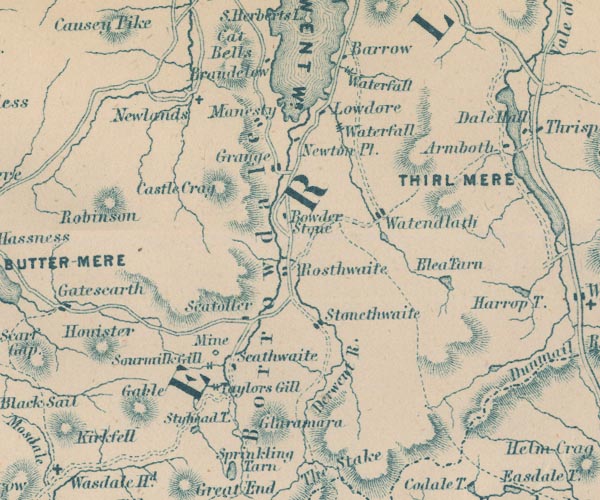
GAR2NY21.jpg
"Mine"
circle
item:- JandMN : 82.1
Image © see bottom of page
item:- geology; pencil; smit mark
 goto source
goto sourcePage 155:- "... he may see the place,- if he looks up the hill the left,- whence was drawn the modern product that has in modern times, distinguished the dale,- the blacklead of which the Keswick pencils are made. It is understood that the productiveness of the mine has much lessened; and the works are, we believe, often suspended; but, while the best ore brings 30s. per lb., there will be more or less perseverance in seeking it. The heaps of rubbish, high up the mountain, show the spot. In the clay slate of the mountain is a bed of greenstone rock; and "nests" or "sops" or "bellies" of black lead are found in the greenstone."
 goto source
goto sourcePage 156:- "The plumbago is the finest ever discovered: but there is great uncertainty about finding it. At one time, a mass of it was discovered lying along like a mighty tree, the thicker part being of the finest quality, and the ramifications of a poorer, till, at the extremities, it was not worthy even to clean stoves. At other times the searchers have been altogether at fault, for a long time together. There was a time when the value of this plumbago was so little known that the shepherds used it freely to mark their sheep: and next, the proprietors were obtaining from thirty to forty shillings a pound for the lead of one single "sop" which yielded upwards of twenty-eight tons. Those were the days when houses were built at the entrance, where the workmen were obliged to change their clothes, under inspection, lest they should he tempted to carry away any of the precious stuff in their pockets."
placename:- Graphite Mine, The
placename:- Plumbago Mine, The
item:- graphite; Winkle's Pipe; Gill's Level; Farey's Level
 goto source
goto sourcepage 111:- "The most remarkable of the mines on the Volcanic Series of English Lakeland is the"
"GRAPHITE (OR PLUMBAGO) MINE."
"The Graphite Mine is situated on the eastern side of Seatoller Fell, near the hamlet of Seathwaite, about nine miles from Keswick. It belonged originally, together with the rest of the manor of Borrowdale, to the Monks of Furness Abbey: and having at the dissolution of that monastery fallen to the crown, it was granted by James I. to William Whitmore and Jonas Verdon, who by a deed dated 28th November, 1614, sold and conveyed the manor, except the Graphite Mine, to Sir Wilfrid Lawson, and thirty-six others. About that time, or soon after, the mine became the property of Sir John Banks, and is still owned by his descendants."
"The graphite found in this mine is remarkable for its purity; indeed it is unequalled by any other of its kind in the world. It was at one time considered of such importance as to merit a special Act of Parliament for its protection, which was passed 25th George II., cap.10, and states that the mineral is necessary for "divers useful purposes, and more particularly in the casting of bomb-shells, round-shot, and cannon-balls," and makes it a felony "to enter unlawfully any mine, or wad-hole of wad, or black-cawke, commonly called black-lead, or unlawfully taking or carrying away any wad, &c., therefrom, or buying or receiving the same, knowing it to be unlawfully taken." But an illicit trade was carried on, nevertheless, between the miners and certain Jews who came regularly to the George Hotel, Keswick, to buy it. In the year 1800 it was deemed necessary that a house should be built over the mouth of the principal level, and armed men were kept on guard there during the night. The miners were also stripped and carefully searched on leaving their work; and when the graphite was sent to the Company's warehouse in London, an armed escort accompanied it as far as Kendal."
"Robinson says, "The most remarkable mundic-vein upon these mountains is that we call wad, or black lead. Its composition is a black pinguid, and shining earth, impregnated with lead and antinomy. The ore is of more value than either copper, lead, or iron. Its natural uses are both medicinal and"
 goto source
goto sourcepage 113:- ""mechanical. It's a present remedy for the cholick, it easeth the pain of gravel, stone, and strangury; and for these and the like uses it's much bought up by apothecaries and physicians, who understand more of its medicinal uses than I am able to give account of."
""The manner of the country peoples' using it, is thus: first they beat it small into meal, and then take as much of it in white wine, or ale, as will lie upon a sixpence, or more if the distemper require it."
""It operates by urine, sweat, and vomiting. This account I had from those who had frequently used it in these distempers with good success; besides those uses that are medicinal, it hath many other uses, which increase the value of it."
""At the first discovery of it the neighbourhood made no other use of it but for marking their sheep; but it's now made use of to glazen and harden crucibles and other vessels made of earth or clay, that are to endure the hottest fire; and to that end it's wonderfully effectual, which much enhanceth the price of such vessels."
""By rubbing it upon iron arms, as guns, pistols, and the like, and tinging of them with its colour, it preserves them from rusting."
""It's made use of by dyers of cloth, making their blues to stand unalterable; for these and other uses it's bought up at great prices by the Hollanders and others.""
"There are eight or more veins in the Graphite Mine, and these traverse a somewhat peculiar rock formation, consisting of a dyke of highly altered diorite, lying between two masses of compact blue diabase. The ash rocks on both sides of these intrusive masses are greatly metamorphosed. The dyke of diorite extends about 300 fathoms, in N.N.W. and S.S.E direction; it contains numerous quartz strings, and on one, if not both sides, it is bounded by veins. The graphite occurs chiefly in the blue diabase, but partly also in the diorite and ash. Its origin is involved in great obscurity; consisting as it does, almost wholly of carbon, it must have been derived either from vegetable or animal matter, but the rocks of the volcanic series contain very little carbon, and none of the beds of Skiddaw Slate met with elsewhere contain more than a fraction of the quantity required to account for the masses found in this mine."
"The deposits of graphite are not found in the veins, as is the case with other minerals, but in sops, or pipes, of various sizes, at some little distance from them. Multitudes of strings, glazed with graphite, diverge from the veins in every direction, and in some instances run parallel with them. Some of these strings terminate at a short distance from the veins, while others extend six or"
 goto source
goto sourcepage 114:- "eight fathoms; and it is in driving along these strings that the deposits of graphite are found. One of these, discovered in 1778, produced 417 casks, containing 70 lbs. each of the best graphite, which at 30/- per pound, the price then current, would represent L43,785. A deposit found in 1803, yielded 31¼tons, which at the same price would realize L105,00. During this year (1803), L3,795 was expended in working the mine, and the net profit realised was L92,690. In 1812, Winkle's pipe was discovered, and 87 casks of the best quality, and 495 casks of inferior graphite were obtained from it. The 87 casks of best quality alone realised L9,135."
"After this date the search for the mineral was less successful, and the price rapidly increased; the produce of a deposit found in 1829 was sold at 35/-, and one found in 1833, at 45/- per pound. About this time, however, the pencil manufacturers discovered that an inferior species of foreign graphite, when compressed, could be utilised for their purpose, therefore, the demand for Borrowdale graphite decreased, and the price again descended to 30/- per pound."
"Since 1833 the mine has been worked at intervals by various parties; but although a considerable extent of ground has been explored, no deposit of value has been found."
"It is said that the mineral was first discovered between Gill's and Farey's levels, where the grand pipe comes to the surface, (see diagram), by the uprooting in a storm of an ash tree, which grew upon the place."
placename:- Graphite Mine
placename:- Plumbago Mine
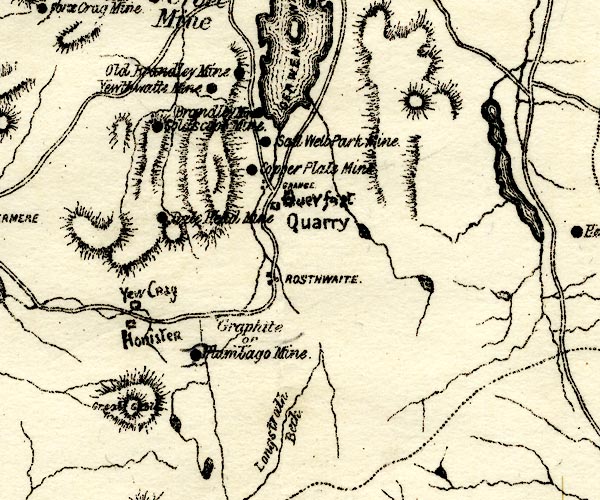
PST2NY21.jpg
"Graphite or Plumbago Mine"
mine symbol
item:- JandMN : 162.2
Image © see bottom of page
placename:- Graphite Mine
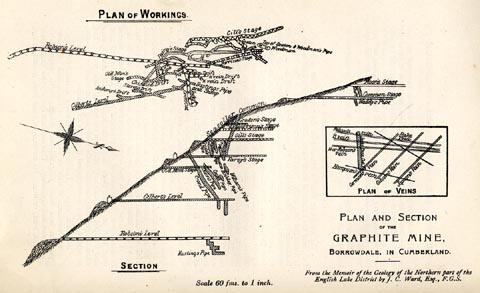 click to enlarge
click to enlargePST325.jpg
On p.112 of Mines and Mining in the English Lake District, by John Postlethwaite.
printed, lower right "PLAN AND SECTION / OF THE / GRAPHITE MINE, / BORROWDALE, IN CUMBERLAND. / From the Memoir of the Geology of the Northern part of the / English Lake District by J. C. Ward, Esq., F.G.S."
printed, lower centre "Scale 60 fms. to 1 inch."
item:- JandMN : 162.27
Image © see bottom of page
item:- pencil; pencil works; plumbago
MSN1P022.txt
Page 22:- "..."
"At the head of Borrow-dale, ... there is a mine of plumbago,- what is commonly called black-lead. There is a pencil-factory there, where you may buy pencils marked with your own name in gold letters."
placename:- Graphite Mine, The
placename:- Plumbago Mine, The
item:- graphite; Winkle's Pipe; Gill's Level; Farey's Level
 goto source
goto sourcepage 111:- "The most remarkable of the mines on the Volcanic Series of English Lakeland is the"
"GRAPHITE (OR PLUMBAGO) MINE."
"The Graphite Mine is situated on the eastern side of Seatoller Fell, near the hamlet of Seathwaite, about nine miles from Keswick. It belonged originally, together with the rest of the manor of Borrowdale, to the Monks of Furness Abbey: and having at the dissolution of that monastery fallen to the crown, it was granted by James I. to William Whitmore and Jonas Verdon, who by a deed dated 28th November, 1614, sold and conveyed the manor, except the Graphite Mine, to Sir Wilfrid Lawson, and thirty-six others. About that time, or soon after, the mine became the property of Sir John Banks, and is still owned by his descendants."
"The graphite found in this mine is remarkable for its purity; indeed it is unequalled by any other of its kind in the world. It was at one time considered of such importance as to merit a special Act of Parliament for its protection, which was passed 25th George II., cap.10, and states that the mineral is necessary for "divers useful purposes, and more particularly in the casting of bomb-shells, round-shot, and cannon-balls," and makes it a felony "to enter unlawfully any mine, or wad-hole of wad, or black-cawke, commonly called black-lead, or unlawfully taking or carrying away any wad, &c., therefrom, or buying or receiving the same, knowing it to be unlawfully taken." But an illicit trade was carried on, nevertheless, between the miners and certain Jews who came regularly to the George Hotel, Keswick, to buy it. In the year 1800 it was deemed necessary that a house should be built over the mouth of the principal level, and armed men were kept on guard there during the night. The miners were also stripped and carefully searched on leaving their work; and when the graphite was sent to the Company's warehouse in London, an armed escort accompanied it as far as Kendal."
"Robinson says, "The most remarkable mundic-vein upon these mountains is that we call wad, or black lead. Its composition is a black pinguid, and shining earth, impregnated with lead and antinomy. The ore is of more value than either copper, lead, or iron. Its natural uses are both medicinal and"
 goto source
goto sourcepage 113:- ""mechanical. It's a present remedy for the cholick, it easeth the pain of gravel, stone, and strangury; and for these and the like uses it's much bought up by apothecaries and physicians, who understand more of its medicinal uses than I am able to give account of."
""The manner of the country peoples' using it, is thus: first they beat it small into meal, and then take as much of it in white wine, or ale, as will lie upon a sixpence, or more if the distemper require it."
""It operates by urine, sweat, and vomiting. This account I had from those who had frequently used it in these distempers with good success; besides those uses that are medicinal, it hath many other uses, which increase the value of it."
""At the first discovery of it the neighbourhood made no other use of it but for marking their sheep; but it's now made use of to glazen and harden crucibles and other vessels made of earth or clay, that are to endure the hottest fire; and to that end it's wonderfully effectual, which much enhanceth the price of such vessels."
""By rubbing it upon iron arms, as guns, pistols, and the like, and tinging of them with its colour, it preserves them from rusting."
""It's made use of by dyers of cloth, making their blues to stand unalterable; for these and other uses it's bought up at great prices by the Hollanders and others.""
"There are eight or more veins in the Graphite Mine, and these traverse a somewhat peculiar rock formation, consisting of a dyke of highly altered diorite, lying between two masses of compact blue diabase. The ash rocks on both sides of these intrusive masses are greatly metamorphosed. The dyke of diorite extends about 300 fathoms, in N.N.W. and S.S.E direction; it contains numerous quartz strings, and on one, if not both sides, it is bounded by veins. The graphite occurs chiefly in the blue diabase, but partly also in the diorite and ash. Its origin is involved in great obscurity; consisting as it does, almost wholly of carbon, it must have been derived either from vegetable or animal matter, but the rocks of the volcanic series contain very little carbon, and none of the beds of Skiddaw Slate met with elsewhere contain more than a fraction of the quantity required to account for the masses found in this mine."
"The deposits of graphite are not found in the veins, as is the case with other minerals, but in sops, or pipes, of various sizes, at some little distance from them. Multitudes of strings, glazed with graphite, diverge from the veins in every direction, and in some instances run parallel with them. Some of these strings terminate at a short distance from the veins, while others extend six or"
 goto source
goto sourcepage 114:- "eight fathoms; and it is in driving along these strings that the deposits of graphite are found. One of these, discovered in 1778, produced 417 casks, containing 70 lbs. each of the best graphite, which at 30/- per pound, the price then current, would represent L43,785. A deposit found in 1803, yielded 31¼tons, which at the same price would realize L105,00. During this year (1803), L3,795 was expended in working the mine, and the net profit realised was L92,690. In 1812, Winkle's pipe was discovered, and 87 casks of the best quality, and 495 casks of inferior graphite were obtained from it. The 87 casks of best quality alone realised L9,135."
"After this date the search for the mineral was less successful, and the price rapidly increased; the produce of a deposit found in 1829 was sold at 35/-, and one found in 1833, at 45/- per pound. About this time, however, the pencil manufacturers discovered that an inferior species of foreign graphite, when compressed, could be utilised for their purpose, therefore, the demand for Borrowdale graphite decreased, and the price again descended to 30/- per pound."
"Since 1833 the mine has been worked at intervals by various parties; but although a considerable extent of ground has been explored, no deposit of value has been found."
"It is said that the mineral was first discovered between Gill's and Farey's levels, where the grand pipe comes to the surface, (see diagram), by the uprooting in a storm of an ash tree, which grew upon the place."
placename:- Graphite Mine
placename:- Plumbago Mine

PST2NY21.jpg
"Graphite or Plumbago Mine"
mine symbol
item:- JandMN : 162.2
Image © see bottom of page
placename:- Graphite Mine
 click to enlarge
click to enlargePST325.jpg
On p.112 of Mines and Mining in the English Lake District, by John Postlethwaite.
printed, lower right "PLAN AND SECTION / OF THE / GRAPHITE MINE, / BORROWDALE, IN CUMBERLAND. / From the Memoir of the Geology of the Northern part of the / English Lake District by J. C. Ward, Esq., F.G.S."
printed, lower centre "Scale 60 fms. to 1 inch."
item:- JandMN : 162.27
Image © see bottom of page
placename:- Graphite Mine
item:- black lead; graphite
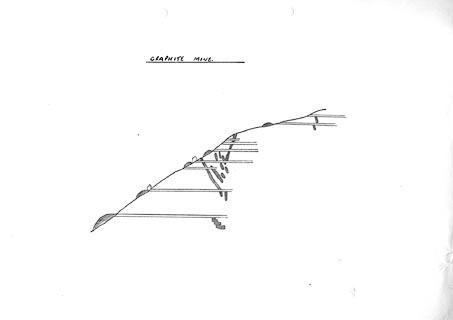 click to enlarge
click to enlargeKMR24.jpg
"GRAPHITE MINE"
item:- private collection : 82
Image © see bottom of page
"BLACK LEAD MINE"
"FEW persons, are, perhaps, aware, that there is only one mine of this kind in England. It is situated on the side of Seatoller Fell, a lofty mountain in Cumberland, about eight miles south of Keswick. The view represents the house erected at the entrance, for the residence of the overseer."
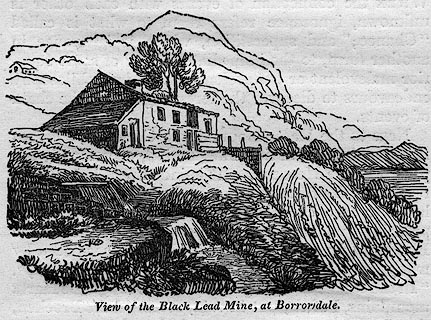 click to enlarge
click to enlargePR0002.jpg
"The period when this mine was discovered is unknown, but it was certainly worked previous to the seventeenth century, and has been occasionally open ever since. The mineral has also been found in Ayrshire, Inverness-shire, and in foreign countries, but of veru inferior quality."
"Various names have been given to the mineral found here, but as may of them denote other substances, they do not appear very appropriate. It is called on the spot, wad, and in other places plumbago, or black lead, though lead, properly so called, forms no part of its composition. The terms black cawke and graphite have likewise been applied to it, though it is actually carbonate of iron, consisting of 90 parts of charcoal and 10 of iron. It is principally used for the manufacture of pencils, great quantities of which are made at Keswick; but also employed in making crucibles, polishing iron, diminishing the friction of machinery, &c."
"The mine was formerly worked only at intervals, a sufficient quantity being procured in a short time to last for several years; but the market being considerably extended, and the difficulty of finding the mineral increased, the working has lately been carried on more constantly."
"The wad is not found in veins, but in irregular masses, some of which weigh as much as four or five pounds. Many of these pieces are of little value, being hard and gritty; but those which are soft and of fine texture are worth several guineas a pound. These masses are usually found in the form of a tree, the trunk being of the finest quality, and the branches inferior to it. When taken out of the mine, the wad is sorted according to its various qualities, and the best sent to London, where it is sold to the dealers once a month. The pencil-makers of Keswick receive their supply from the metropolis, as the proprietors of the article will not allow any to be sold till it has been deposited in their own warehouse."
"In order to make pencils, the black lead is sawed into quare slips, which are fitted into a groove made in a piece of wood, and another slip of wood glued over them. A soft wood, such as cedar, is usually employed for the purpose, that the pencil may be more easily cut. In the ever-pointed pencils, the lead is formed in the shape of small cylinders instead of square slips."
"The inferior pencils, hawked about at a cheap rate, are made of the refuse of the mineral, stirred into melted sulphur. They may be detected by holding them to a candle, or to a red hot iron, when they yield a bluish flame, with a strong smell, resembling that of burning brimstone. Pure black lead produces neither smell nor fume, and suffers no apparent alteration in a moderate heat."
item:- JandMN : 154
Image © see bottom of page
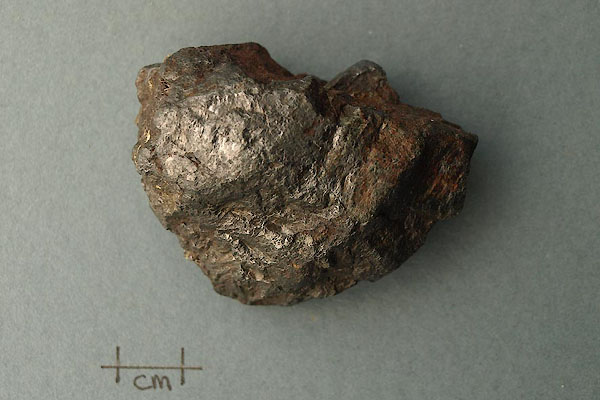
BXO38.jpg Rock, hand specimen of graphite from spoil heap at the black lead mine, Seathwaite, Borrowdale, Cumberland, NY235127, 26 February 2007.
(taken 26.2.2007)
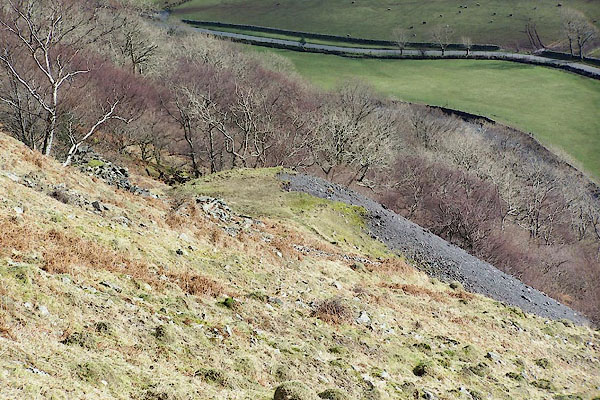
BNG42.jpg Ruined building and tip.
(taken 26.2.2007)
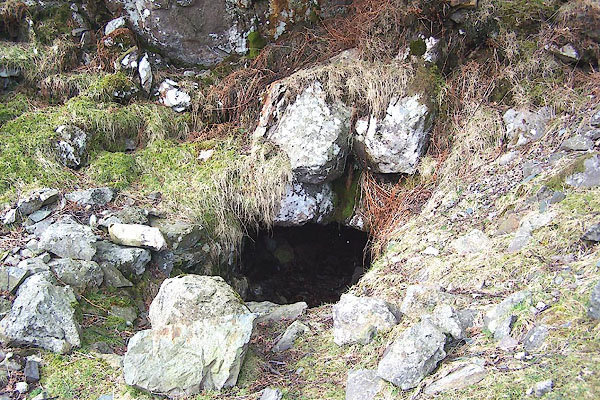
BNG58.jpg Adit.
(taken 26.2.2007)
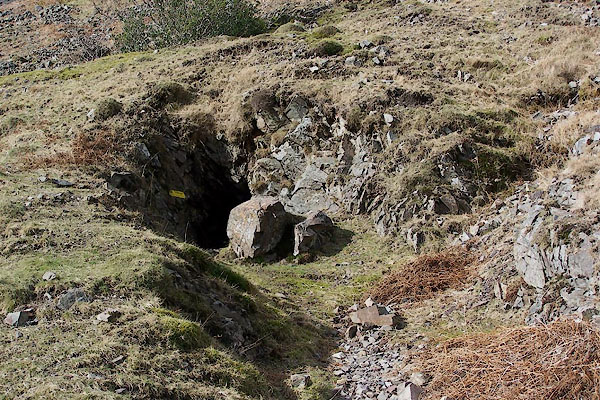
BNG47.jpg Adit; worth looking in at BUT beware, it drops away suddenly when it intersects the next shaft.
(taken 26.2.2007)
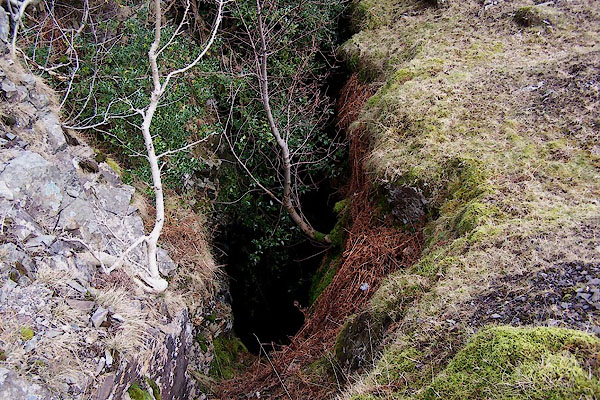
BNG48.jpg Shaft.
(taken 26.2.2007)
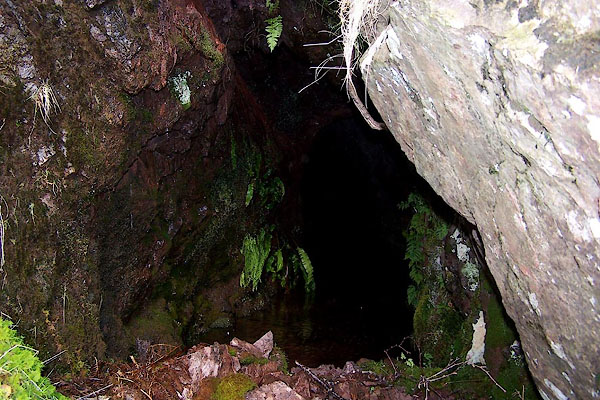
BNG49.jpg Shaft.
(taken 26.2.2007)
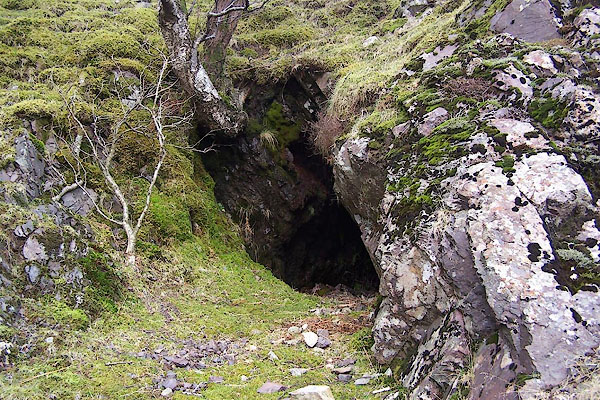
BNG50.jpg Adit.
(taken 26.2.2007)
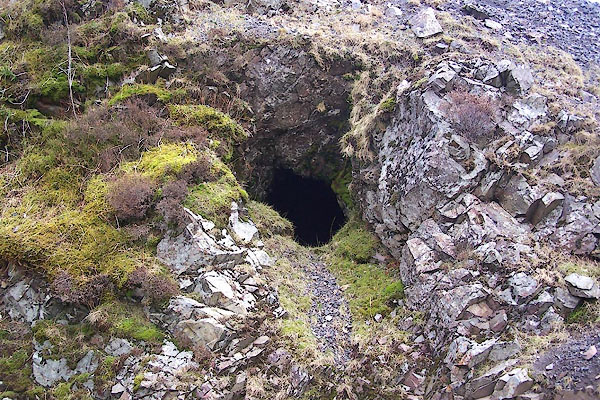
BNG51.jpg Adit; difficult to see, bad drop just within.
(taken 26.2.2007)
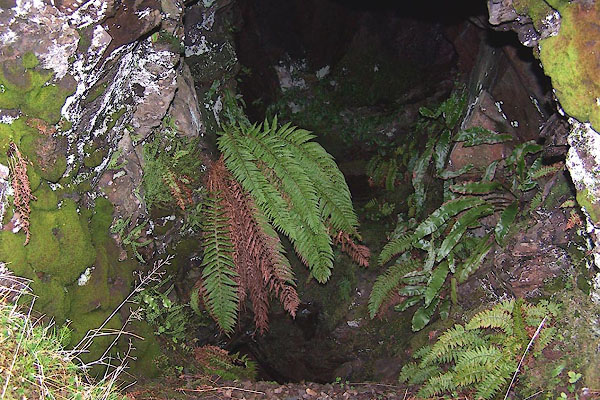
BNG52.jpg Adit; difficult to see, bad drop just within.
(taken 26.2.2007)
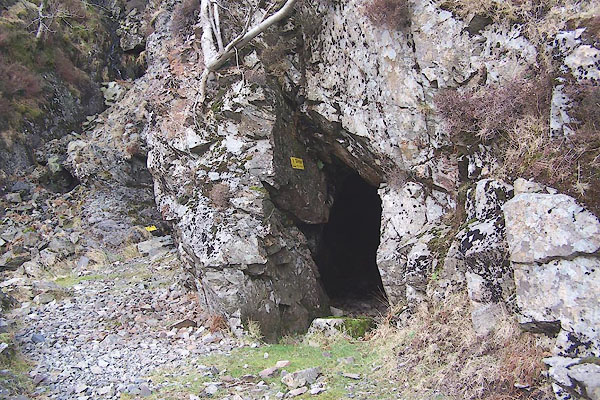
BNG53.jpg Adit.
(taken 26.2.2007)
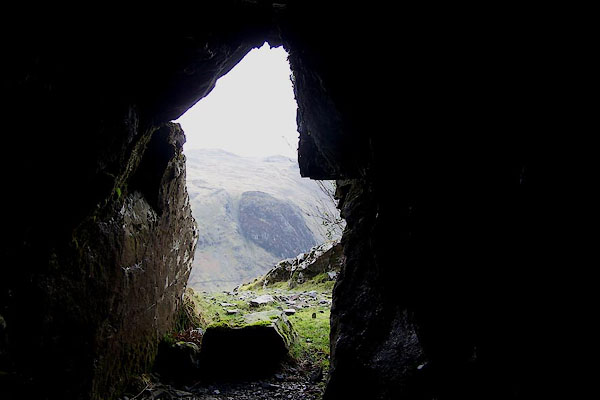
BNG54.jpg Adit.
(taken 26.2.2007)
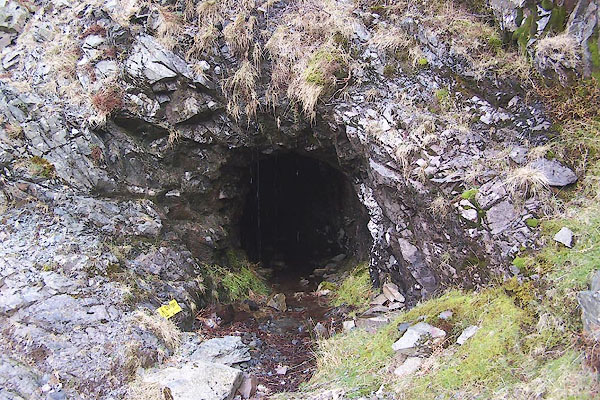
BNG55.jpg Adit.
(taken 26.2.2007)
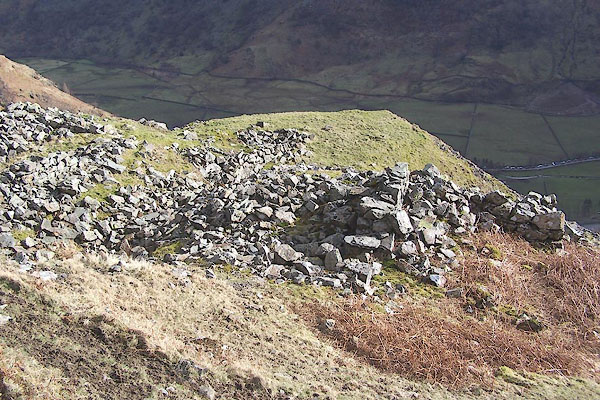
BNG56.jpg Ruined building and tip.
(taken 26.2.2007)
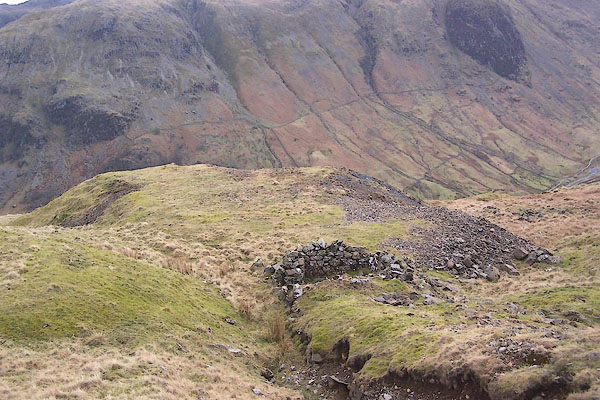
BNG57.jpg Ruined building and tip.
(taken 26.2.2007)
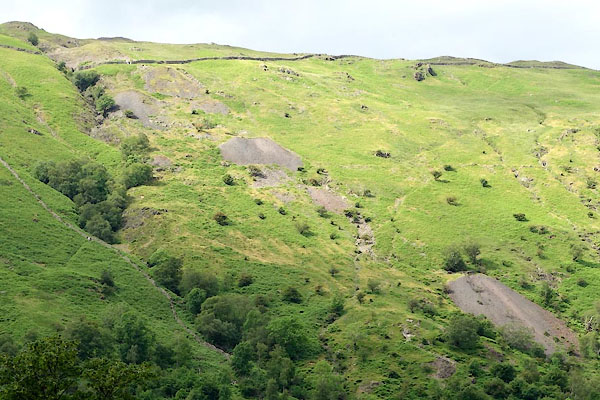
CAZ11.jpg (taken 23.6.2014)
